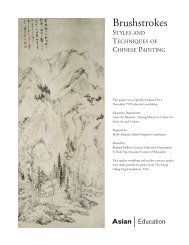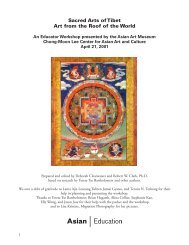Download PDF - Asian Art Museum | Education
Download PDF - Asian Art Museum | Education
Download PDF - Asian Art Museum | Education
Create successful ePaper yourself
Turn your PDF publications into a flip-book with our unique Google optimized e-Paper software.
is less than three feet square. Notice the broom hanging on the outer wall of the hut. This is<br />
to clear fallen leaves or snow from the path before guests arrive. Guests remove their shoes<br />
before entering the hut, thus the sandals below the opening. Notice also the sky light in the<br />
thatched roof for moon viewing or allowing reflected light from snow to illuminate the<br />
small dark hut. Yuin was declared an Important Cultural Property by the Japanese government.<br />
The Tea Garden.<br />
The garden path, called roji (“dewy path”), leading to the teahouse was also constructed<br />
with care. The path was usually marked by irregular stepping stones interspersed with moss<br />
and other plants. Walking along the roji guests can prepare themselves for the tea gathering.<br />
They leave behind the cares of their daily life, the bustle of the city, and savor the fresh<br />
smells and sights of this miniature wilderness. Depending on the size of the garden, the path<br />
may be punctuated with a stone lantern, a small pond or stream, and always by a stone<br />
basin filled with water for guests to rinse their mouths and hands before entering the tea<br />
room.<br />
Activity/Discussion<br />
1) What does it mean to designate a place an Important Cultural Property? In Japan, there<br />
are also Living National Treasures (also known as holders of Intangible Cultural Properties—masters<br />
of traditional Japanese crafts recognized by the government) and National<br />
Treasures (objects deemed to be of supreme significance to Japanese identity and protected<br />
by the government). Working in groups, have students brainstorm to nominate<br />
Living National Treasures (living people) and National Treasures (objects) familiar to<br />
them (can be from any culture they know.) Have them present to the class (or write an<br />
essay) about their nomination(s) and reasons for their selections.<br />
2) Create your own three-dimensional tea house. (See Activity 4)<br />
Show students this slide and talk about the different components of the tea house<br />
(crawl-through door, tatami mat seating, tokonoma, stone basin, and dewy path). Discuss<br />
wabi aesthetics of the Japanese tea house (use of unpainted wood, thatched roof,<br />
plain brown walls, minimal interior decoration, beautiful garden setting).<br />
Xerox and distribute the diagrams in Activity 4. Explain that tea masters like Sen Rikyu<br />
and Sen Sotan designed tea houses using three dimensional models like the ones they<br />
are about to create. They used these models to visualize their design in three dimensions;<br />
to carefully chose spatial relationships and try out different placements of doors,<br />
windows, etc.<br />
Have students color and build their tea house. They may like to collect pebbles, twigs,<br />
leaves and other natural materials to decorate their garden. They may also prepare a<br />
miniature hanging scroll and flowers for their tokonoma inside the tea house. Tea masters<br />
usually gave their tea houses interesting names, such as “Further Retreat,” “Cold<br />
Cloud Arbor,” and “Hut of Uncertainty.” Have students devise a name for their own<br />
retreats.<br />
<strong>Asian</strong> <strong>Art</strong> <strong>Museum</strong> <strong>Education</strong> Department
















